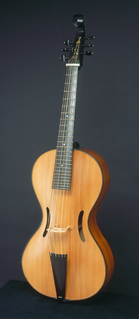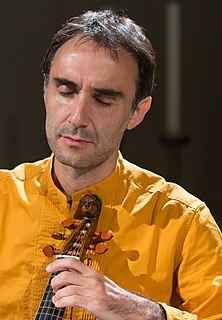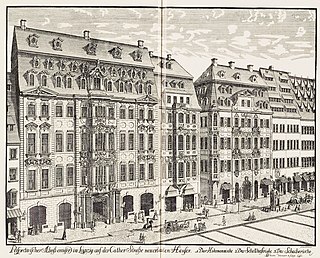
The viol, viola da gamba, or informally gamba, is any one of a family of bowed, fretted and stringed instruments with hollow wooden bodies and pegboxes where the tension on the strings can be increased or decreased to adjust the pitch of each of the strings. Frets on the viol are usually made of gut, tied on the fingerboard around the instrument's neck, to enable the performer to stop the strings more cleanly. Frets improve consistency of intonation and lend the stopped notes a tone that better matches the open strings. Viols first appeared in Spain in the mid-to-late 15th century, and were most popular in the Renaissance and Baroque (1600–1750) periods. Early ancestors include the Arabic rebab and the medieval European vielle, but later, more direct possible ancestors include the Venetian viole and the 15th- and 16th-century Spanish vihuela, a 6-course plucked instrument tuned like a lute that looked like but was quite distinct from the 4-course guitar.

The viola d'amore is a 7- or 6-stringed musical instrument with sympathetic strings used chiefly in the baroque period. It is played under the chin in the same manner as the violin.

The arpeggione is a six-stringed musical instrument fretted and tuned like a guitar, but with a curved bridge so it can be bowed like a cello, and thus similar to the bass viola da gamba. The instrument is sometimes also called a guitar violoncello. The body shape of the arpeggione is, however, more similar to a medieval fiddle than either the guitar or the bass viol. It is essentially a bass viol with a guitar-type tuning, E–A–d–g–b–e'. The arpeggione is especially suited to playing runs in thirds, double stops, and arpeggios.

Marin Marais was a French composer and viol player. He studied composition with Jean-Baptiste Lully, often conducting his operas, and with master of the bass viol Monsieur de Sainte-Colombe for six months. In 1676 he was hired as a musician to the royal court of Versailles and was moderately successful there, being appointed in 1679 as ordinaire de la chambre du roy pour la viole, a title he kept until 1725.

Johann Caspar Kerll was a German baroque composer and organist. He is also known as Kerl, Gherl, Giovanni Gasparo Cherll and Gaspard Kerle.
The year 1701 in music involved some significant musical events and new works.
Hille Perl is a German virtuoso performer of the viola da gamba and lirone. She is considered to be one of the world's finest viola da gamba players, specializing in solo and ensemble music of the 17th and 18th centuries. She has a particular interest in French Baroque repertoire for seven-string bass viola da gamba. She also performs Spanish, Italian, German, and modern repertoire for the instrument and has released many CDs.

Gottfried Finger, also Godfrey Finger, was a Moravian Baroque composer. He was also a virtuoso on the viol, and many of his compositions were for the instrument. He also wrote operas. Finger was born in Olomouc, modern-day Czech Republic, and worked for the court of James II of England before becoming a freelance composer. The fact that Finger owned a copy of the musical score of the work Chelys by the Flemish composer Carolus Hacquart suggests that the two composers may have worked together in England.

Paolo Pandolfo is an Italian virtuoso player, composer, and teacher of music for the viola da gamba, born on January 31, 1964.

Vittorio Ghielmi is an Italian musician, conductor, compose Compared by critics to Jasha Heifetz ("Diapason") for his virtuosity, and described as "An Alchemist of sound" for the intensity and versatility of his musical interpretations, Vittorio Ghielmi attracted notice while still very young for his new approach to the viola da gamba and to the sound of early music repertoire. He is Professor for viola da gamba and Head of the Institut für Alte Musik at the Mozarteum Universität Salzburg and Visiting Professor at the Royal College of London. He is graduate at the Università Cattolica di Milano.
Johannes Schenck was a Dutch musician and composer.
Adam Drese was a German composer, kapellmeister and bass viol player of the baroque period.

The Sonata in G major for two flutes and basso continuo, BWV 1039, is a trio sonata by Johann Sebastian Bach. It is a version, for a different instrumentation, of the Gamba Sonata, BWV 1027. The first, second and fourth movement of these sonatas also exist as a trio sonata for organ.
William Young was an English viol player and composer of the Baroque era, who worked at the court of Ferdinand Charles, Archduke of Austria in Innsbruck. The sonatas which he published in 1653 were some of the earliest sonatas produced by an English composer.
Bacchus, Ceres en Venus is a 1686 Dutch-language pastoral opera by Johan Schenck.
De triomfeerende Min is a 1678 pastoral semi-opera by Carolus Hacquart to celebrate the Peace of Nijmegen.
Opera in the Dutch-language is a minor tradition in the opera history of the Netherlands. Since the earliest operas were staged in the Netherlands in the 17th Century the preference has always been for original Italian, French and German versions, or occasionally French translations of Italian and German works.
Jonathan Dunford is an American violist specialising in the baroque repertoire.
Jérôme Hantaï is a viola da gamba player and fortepianist.
Carolus is the medieval Latin form of the name Charles, notably the name of Charlemagne (742–814).









